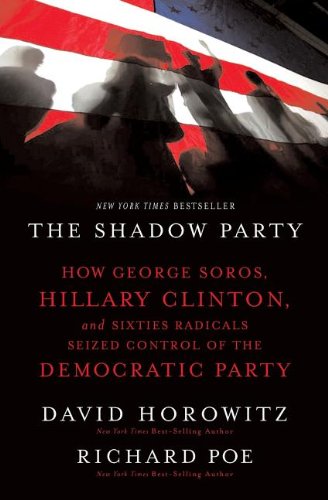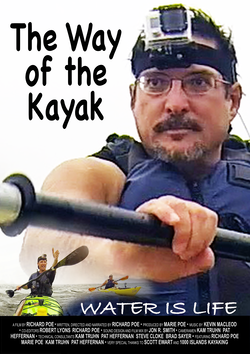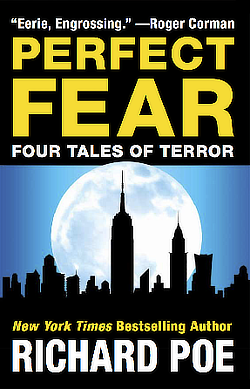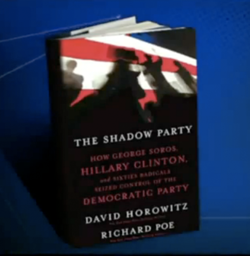Soros Shadow Party Stalks DeLay
|
by Richard Poe Tuesday, August 15, 2006 2:45 pm Eastern Time |
Archives Comments |
Soros Shadow Party Stalks DeLay
by Richard Poe
FrontPageMagazine.com
April 11, 2005
ON THE DAY that Terri Schiavo died – victim of a court order condemning the brain-damaged woman to death by thirst and starvation – Representative Tom DeLay of Texas did what few politicians have the courage to do these days. He spoke his mind.
 |
“This loss happened because our legal system did not protect the people who need protection most,” DeLay told Fox News on March 31. “The time will come for the men responsible for this to answer for their behavior.”
DeLay’s strong language worried some Republicans. They pointed to an ABC News poll of March 21 purporting to show that 63 percent of Americans wanted Mrs. Schiavo’s feeding tube removed and that 70 percent wanted Congress to stay out of the matter.
However, Tom DeLay does not take his guidance from polls.
On the day of Mrs. Schiavo’s death, DeLay told reporters that Congressional investigators, “will look at an arrogant and out of control judiciary that thumbs its nose at Congress and the President.” He suggested that some judges involved in the Schiavo case might face impeachment. “I never thought I’d see the day when a U.S. judge stopped feeding a living American so that they took fourteen days to die,” he said.
Fainter hearts in the Republican Party cringed. Yet the very next day, on April 1, pollster John Zogby released survey results showing that 79 percent of Americans opposed removing a feeding tube from someone in Terri Schiavo’s condition. Only 9 percent would remove it.
How to account for such wildly differing results?
It turned out that ABC had used a push poll – a survey worded in such a way as to ensure a predetermined outcome. The ABC poll had misled respondents into thinking that Mrs. Schiavo had “no consciousness” and that her condition was “irreversible.”
In the end, neither poll mattered to DeLay. He had spoken his mind boldly, as was his habit. Americans in the heartland took note. Calls of gratitude swamped radio talk shows, such as Rush Limbaugh’s and Sean Hannity’s.
DeLay had given voice to tens of millions of ordinary, hard-working Americans whose opinions seldom reach mass media organizations nor the elite pollsters they employ. He spoke for an anguished but silent majority which recoiled in horror from Terri Schiavo’s killing, and from the runaway judicial system which had ordered it.
DeLay had given middle Americans more than just a voice. He had given them hope. From the Democrat point of view, that made DeLay a very dangerous man.
The Hammer
Through the Schiavo case, grassroots America discovered why DeLay’s Congressional foes call him, “The Hammer.”
At age 58, DeLay stands unrivaled as the most powerful and effective Republican leader in Congress. Virtually every Republican legislative breakthrough of the last decade, from the Contract with America to welfare reform and the Balanced Budget Act owes its passage in large part to DeLay’s skill at persuasion.
His public profile is rising fast. Between September 1999 and February 2005, the proportion of Americans who recognize DeLay’s name soared from 46 to 76 percent, according to a Gallup survey commissioned by CNN and USA Today.
Predictably, his rising stature has made him a priority target for dirty tricksters of the left. His ascent to House Majority Leader in January 2003 triggered an onslaught of non-stop mud-slinging. DeLay has endured a two-year barrage of nebulous, petty and mostly ill-founded ethics charges, attack ads, media smear campaigns and dubious popularity polls.
So far, he has weathered the storm. But his accusers persist. In the last three weeks, their attacks have reached a furious crescendo, with calls for DeLay’s resignation screaming from blog sites, editorial pages and television screens across the land.
Mainstream media portray DeLay’s accusers as disinterested “public interest groups” – non-profit organizations standing guard over public virtue, their judgment unsullied by corruption or party allegiance. In reality, of course, the “public interest groups” attacking DeLay have roots in the partisan struggle as deep as any in Washington.
Much evidence suggests that a hidden agenda lurks beneath the camouflage of this sudden outpouring of “ethics” charges. In certain cases, the organizations promoting these charges show a history and money trail bespeaking a highly specific allegiance.
The pattern of the attack suggests that DeLay may be confronting a political machine far wealthier, more ruthless and better skilled at media manipulation than the Democratic Party itself. When the hysteria subsides and the facts are examined, we may learn that DeLay’s foe all along has been the Shadow Party – a murky and inscrutable entity controlled by leftwing billionaire George Soros.
The Soros Attack Machine
“Tom DeLay: He’d like to wash his hands of corruption. […]” a voice intones, while a man wearing cuff links and a Rolex watch scrubs his hands. “He can’t wash his hands of corruption. But Congress can certainly wash its hands of Tom DeLay.”
This 30-second television ad began running in selected Congressional districts on Thursday, March 31 – only the latest in a long series of media smears targeting DeLay.
“Over a five-day span, ending last Thursday, TV and radio stations and print publications from around the country featured at least 290 stories” discussing ethics allegations against DeLay, reports Alexander Bolton in the March 23 edition of The Hill.
The allegations mostly involve aggressive fundraising tactics of the sort the Clintons honed to a science. To what extent DeLay may be guilty of such missteps remains unclear. Crystal clear is the double standard being applied to his case.
A small but dedicated core of self-appointed ethics “watchdog” groups have labored to keep the charges against DeLay brightly aflame – among them, the Center for Public Integrity; Common Cause; Democracy 21; Public Campaign and Public Citizen.
Often dubbed “non-partisan” by the press, these groups have a long history of coordination with Soros and his Shadow Party. They are beholden to Soros personally for his financial support. His influence often shows in their choice of targets.
For instance, the TV ad campaign cited above is sponsored by two groups, both heavily funded by Soros. One, the Campaign for America’s Future (CAF), has received more than $300,000 from Soros’ Open Society Institute. The other group, the Public Campaign Action Fund, is a spin-off from the Soros-funded Public Campaign.
In fact, most of the public-interest “watchdogs” currently hounding DeLay are beneficiaries of Soros largesse. All of the groups named have received large contributions from Soros’ Open Society Institute, ranging in size from hundreds of thousands to more than a million, in some cases.
The Ten-Year Coup
George Soros is one of the most powerful men in the world. His foundations disburse as much as $400 million per year. As a global investor, Soros has amassed a personal fortune estimated at $7.5 billion. He controls an additional $11 billion or so through his investment funds. Soros is one of a handful of mega-investors who can move global markets simply by expressing an opinion on CNN’s Moneyline.
Despite his power, most Americans never heard of Soros until November 11, 2003, when he declared in a Washington Post interview that, “America under Bush is a danger to the world.” Ousting Bush, said Soros, “is the central focus of my life […] a matter of life and death.” Asked if he would spend his last penny to defeat Bush, Soros replied, “If someone guaranteed it.”
In the end, Soros did not spend anything close to his last penny on the campaign. But he didn’t need to. Soros achieved something far more important than merely putting John Kerry in the White House. He gained control of the Democratic Party itself.
Soros’ power grab was ten years in the making. Beginning in 1994, he began pouring millions into the campaign finance reform lobby. The result was the Bipartisan Campaign Reform Act of 2002 (BCRA), commonly known as the McCain-Feingold Act.
As a Wall Street Journal editorial noted on December 30, 2003: “Combine… the $1.7 million that Mr. Soros gave the Center for Public Integrity, the $1.3 million he gave Public Campaign, the $300,000 to Democracy 21, the $625,000 to Common Cause, and the $275,000 to Public Citizen – and you can be forgiven for believing Mr. Soros got campaign finance passed all by himself.”
Note that all five of the organizations listed above are now attacking Tom DeLay.
What did the McCain-Feingold Act do for George Soros? Why did he spend seven years and millions of dollars pursuing it? It now appears to have been a power play, whose purpose was to gain control of the Democratic Party.
The McCain-Feingold Act barred political parties from collecting “soft money” – that is, donations which are earmarked for no particular candidate, and which are therefore exempt from federal limits on their size. Under McCain-Feingold, the parties could only accept heavily regulated “hard money” donations limited to $2,000 per donor, per candidate.
This rule put the Democratic Party in peril. Republicans had long enjoyed a three-to-one advantage over Democrats in raising hard money. Consequently, Democrats depended for their survival on huge donations from unions, corporations and wealthy individuals – that is, they depended on soft money.
Now Soros had cut off the Democrats’ soft-money supply. The Party seemed doomed. But Soros showed them a way out. He offered Democrats an alternate money source – one which he personally controlled. That source was the Shadow Party.
The Shadow Party
Journalists first started using the term “shadow party” in 2003 to describe the network of leftwing NGOs, activist Web sites, Section 527 “stealth PACs,” public employee unions and radical foundations which Democrat activists used to circumvent McCain-Feingold in the 2004 campaign. Working independently of the Democratic Party, these private groups managed to raise a record $300 million in political contributions for Democrats running in 2004.
The Shadow Party has gotten a fair amount of press. However, most reporters failed to describe it accurately. They characterized the Shadow Party as a loose network of private groups that arose more or less spontaneously from grassroots America. Nothing could have been further from the truth.
The Shadow Party is a top-down creation. George Soros founded it, organized it and runs it to this day, through a tightly-integrated, corporate-style command structure. Soros fulfills a role in the Shadow Party comparable to that of chairman of the board, while former Clinton deputy chief of staff Harold Ickes serves as de facto CEO.
It took years of patient sleuthing to penetrate the Shadow Party’s secrets – a research effort led by conservative activist David Horowitz, who heads the Center for the Study of Popular Culture (CSPC) in Los Angeles. Much of this research can now be found at DiscovertheNetwork.org – a searchable, online database of the organized left which Horowitz launched in February 2005.
DiscovertheNetwork.org illuminates the intricate personal and financial relationships binding leftwing organizations together. While compiling this database, Horowitz and his team uncovered the hidden command structure that drives Soros’ Shadow Party.
As one of the researchers on that team, I worked with Horowitz to follow the money trail and identify the specific levers of control by which Soros steers his Shadow Party. Horowitz and I co-wrote a three-part exposé published on the CSPC Web site FrontPageMagazine.com in October 2004. In it, we revealed that Soros administers his network through a core group of seven non-profit organizations, which we named the Seven Sisters. They are, in alphabetical order: America Coming Together; America Votes; Center for American Progress; Joint Victory Campaign 2004; The Media Fund; MoveOn.org; and the Thunder Road Group.
Through these Seven Sisters, Soros and his team convey money, information and marching orders down the line to a much larger network encompassing radical public employee unions, leftwing foundations and street-level activist groups.
The network has emerged as a veritable shadow government, wielding the power to make or break politicians at the highest level. The sudden convergence of Soros-sponsored “public interest” groups in the attack on DeLay smacks of coordination. It suggests that Soros has focused the full might of his Shadow Party on an effort to discredit Tom DeLay and force his resignation as House Majority Leader.
With DeLay neutralized, Democrats will be free to pursue another priority goal of George Soros – to spend the next three years packing our federal courts with leftwing extremists, right up to the U.S. Supreme Court. They will fill the benches with corrupt, radical judges cut from the same cloth as those who sent Terri Schiavo to her grave.
The Left Triumphant
In the 2004 election cycle, Soros donated about $27 million of his personal funds to anti-Bush forces – the largest political contribution from a single individual in U.S. history. More importantly, the Shadow Party Soros created raised more than $300 million for the cause.
John Kerry may have lost the election, but the Shadow Party emerged triumphant. The Democrats can no longer function without Shadow Party cash.
Regarding the Democratic Party, MoveOn PAC director and Soros operative Eli Pariser boasted, “Now it’s our party. We bought it, we own it.”
The Shadow Party’s ascendancy marks a victory for the left – and in particular for Soros’ idiosyncratic vision of social utopia. Soros’ philanthropy has long promoted a phantasmagoria of radical causes such as medical rationing, euthanasia, gay rights, gun control, avant-garde education, regulation of political speech through campaign finance laws and the promotion of judicial activism. In his 1998 book The Crisis of Global Capitalism, Soros foretold the end of free enterprise as we know it.
His Shadow Party has emerged today as the ultimate instrument for inflicting his radical agenda on America.
In the November 29, 2004 issue of the Marxist journal The Nation, Robert L. Borosage co-wrote an article with Nation editor Katrina Vanden Heuvel. They wrote:
“[P]rogressives drive this party now – we provide the energy, the organizers, the ground forces, the ideas, and much of the money. We should organize the opposition [against Republicans]. Progressives should mount a powerful assault on Republican boss Tom DeLay.”
Borosage typifies the sort of people who fill high-level leadership positions in the Shadow Party. A hard-left militant during the ’60s and a graduate of Yale Law School – where he served as a political mentor to young Hillary Rodham – Borosage subsequently headed the National Lawyers Guild, a radical organization that began in the 1930s as a Soviet front, operated in conjunction with the Communist Party and to this day basks comfortably and proudly in its Communist heritage. Later Borosage headed the Institute for Policy Studies, a far left Washington think tank that has enjoyed close and unsavory involvements with Soviet and Cuban intelligence operations.
Borosage currently serves as co-director of the Campaign for America’s Future (CAF) – a leftwing activist group founded in 1996, whose list of advisors includes Sixties radical Tom Hayden; former SDS president Todd Gitlin; former SDS radical Heather Booth; NOW founder Betty Friedan; Jesse Jackson and social scientist and activist Frances Fox Piven, a founder of the “welfare rights movement” of the late ’60s and early ’70s whose strategy of deliberately overloading welfare rolls to break the “system” actually bankrupted New York City.
In a July 25, 2004 article, Shadow Party operative Simon Rosenberg – who is president of the New Democrat Network – told Matt Bai of The New York Times Magazine that the independent 527 committees which form the backbone of Soros’ Shadow Party would spearhead a “more defiant kind of politics.” As Bai explained, these independent groups could go where no Democrat had gone before. They could confront head-on the “sharp ideological divide between them and the Rush Limbaugh right.” They would be free to attack ideological foes with a Machiavellian abandon previously unknown in mainstream politics – ideological foes such as Tom DeLay.
Of course, DeLay is not the sort of man who would suffer such attacks without a fight. On April 7, as a rising chorus of journalists, pollsters, leftwing activists and “public interest groups” screamed for his resignation as House Majority Leader, DeLay went on the offensive.
Speaking by video to the Judeo-Christian Council for Constitutional Restoration – a conservative religious group – DeLay warned sternly of “a judiciary run amok.”
“The judiciary branch of our government has overstepped its authority on countless occasions, overturning and in some cases just ignoring the legitimate will of the people,” he said. “Our next step, whatever it is, must be more than rhetoric.”
And so it will be. Americans today are aboil with rage that no push poll can hide. DeLay may stand or fall before his attackers. No one can predict his fate. But with or without DeLay, that “next step” of which he spoke will come, and the people will be heard.
Cross-posted from FrontPageMagazine.com 04.11.05
FreeRepublic Comments 04/12/2005 4:48:32 AM ET








